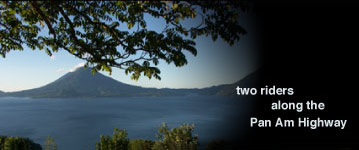
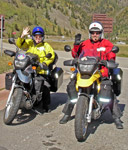
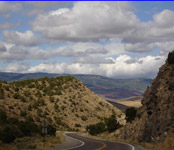
view corresponding gallery | previous entry | next entry
entry 11: mazatlan, mexico to san miguel de allende, mexico 12/19/05
Our stay in Mazatlan was one that you would expect from a good tourist port in Mexico. Good hotels, clean restaurants, plenty of taxis and of course Senior Frog’s. I have never been in one of the restaurants, but their clothing and promotional stores are as popular as Starbucks coffee shops in Seattle. The beaches were great and we somehow avoided getting burned, but both of us are acquiring a slight tan. We did very little in Mazatlan but relax.
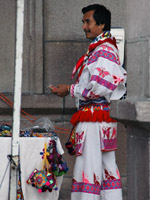 |
| The Huichol people made the zocalo (town square) of Tepic a beautiful place. |
We took off after a couple of days and headed to Puerto Vallarta , stopping for the night in Tepic. It took a bit of work to actually find the center of town, as we jumped off the highway at the first exit sign when staying on the road a few miles more would have put us on the main street. This town loves its one-way streets. They will actual put two one-ways back-to-back, just to keep things interesting. All towns have city squares where hotels and churches can be found. At this time of year, a couple of weeks before Christmas, the squares are decked out with lights and streamers and decorated Christmas trees. The hotel room we checked into, again at a Super 8 motel price, looked right down on the square and we also had a great view of a wonderful looking church. The plaza was packed with shoppers and native Huichol Indians selling handmade beadwork, which are actually sold across Mexico. The only drawback was that we were there on a Friday night and these people know how to dance up a storm! The music quit at 2 am and that’s when we noticed the church bells. They not only rang on the hour but on the half and quarter hour. And they say New York is a city that never sleeps!
We had a great ride the next day, which wound through country side filled with forest and farm land – looking very much like a Pennsylvania landscape with a lot of shade covered, curving roads, but with burros on the road side. Puerto Vallarta was a bit of a disappointment after Mazatlan. The town was packed with tourists (I know we are tourists also but this was over the top) and hotel prices were just like the good old USA – expensive. After riding from one hotel to the next and finding either no vacancy or prices high enough to make you weep, we found a hotel that we liked but they didn’t have any rooms in our price range. Then we found an internet café, found that same hotel online and booked a room at half the rate they quoted us. It seems that Travelocity and Orbitz and the like buy a block of rooms at hotels that only they can sell. A trick that may come in handy down the road, we’ll see. Our taxi ride to downtown was in an open-air vehicle that had a Volkswagen engine but looked like a golf cart on steroids. Along with no windows it also had no shocks, causing re-alignment of the spinal column. Once in-town, we did find a restaurant that was showing the Denver Broncos, which drew a dozen or so fans and let us catch up on the weather (big snow and cold front – 6 degrees) and other happenings back home. One nice theme that we found recurring night after night in Puerto Vallarta was the parades, called posadas, which local parishes and businesses perform from December 1 st to December 15 th. They all start out at least several miles from the towns’ main church and walk their way through the streets, following a float of the Blessed Virgin of Guadalupe. Some of these floats are quite good and all are made with love and dedication to the Virgin.
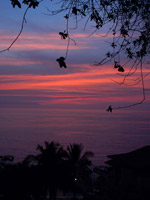 |
| Just another ho-hum sunset along the Pacific Coast. |
Several days in Puerto Vallarta was enough for us so we headed back north to Tepic and then inland. Getting to downtown Tepic was easier this time and on our walk around town I happened to wear my motorcycle boots. Now, I have heard that people judge you by the type of shoe you wear and how well maintained you keep them. Mexico appears to be obsessed with the idea. Every city square has at least two shoe stores and finding someone to shine your shoes is quite easy. Looking down at my road weary boots, encrusted with dirt and small insects, I decided to get one. I was offered a seat and a newspaper (from which I looked at the pictures, as my Spanish is still not up to snuff), but at least I tried to give the impression that I do this every day. That gentleman went to work with a fervor that I can only give to a good steak and he washed, dried and then HAND (no cloth) applied the polish. When he was done my boots were good enough for military inspection and the cost was $1.20. I gave him an even $2 because to me it was more than a shine…it was an experience.
I have to say a bit more about our days on the road and our trusted mounts. Our BMW 650’s have been on 3,000 miles of road outside the U.S. and apart from the one puncture, have really been work horses. No oil consumption to speak of, good acceleration – even though they are close to maximum load, and they take quite the pounding from cobblestones, topes (large and unexpected at times), and roads with patches on patches and of course potholes and dirt roads. Knock on wood, but these bikes have not complained once. And the gas mileage still averages around 65 mpg, at sea level or at 8,000 feet. Again, not my first choice for the trip but so far no complaints.
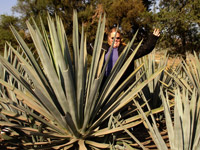 |
| Hanging out in the tequila field. These maguay plants can get quite large. |
Our next stop, Atotonilco Alto, was a small, charming town that we stayed a night in on the way to San Miquel de Allende. It had very narrow streets (all one ways) and after the help of a local fellow we found a hotel that had huge rooms and was extremely clean – for $29. The only item not included was hot water – meaning that only the brave (Lynne) would rinse off the road dust that night. Dinner over-looked the town square – decorated for Christmas - and as it was only 7 pm, we had the dining room to ourselves. Dinner included a taste of a few local tequilas, fried cactus and fajitas. Speaking of tequila, we had been driving through agave fields for days, so when we came upon a roadside distillery offering tours and samples, we couldn’t resist. Thanks to Miguel, our guide, we learned that tequila is made from a certain type of the agave plant, meguay azul, which is only grown in five states in Mexico. The plant is harvested, then the pinas (hearts) are baked for several hours in huge brick ovens, crushed and then the juice is collected. Sugars and yeasts are then added to the juices and the mixture is then put through two distillation processes. At this point the aging begins, ranging from 2 months to 7 years and the end products are then marketed as different grades of tequillas. Other drinks made from the meguay plant are mezcal, the "country cousin" of tequilla made from a different species of the plant; and pulque, a pre-columbian beverage currently disappearing thanks to the popularity of beers in Mexico.
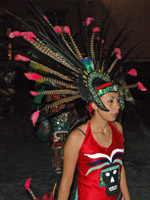 |
| San Miguel de Allende had celebrations in the streets every night. |
Continuing on, after a four hour ride through mountain passes of 9,000 feet, we arrived at San Miguel de Allende. At around 7,400 feet the daytime temperature is in the 60’s and at night it dips into the 40’s. We broke out our warm weather street clothes for the first time in Mexico . This town was a challenge to ride around in because the streets are paved with stones the size of large potatoes, most being exposed halfway and spaced just wide enough to grab your front tire - PLUS the town is built on a hillside – PLUS there is no rhyme or reason to their traffic patterns. After getting the bikes safely parked, we found San Miguel to be a good mix of art, culture and good food. The area has drawn a good number of Europeans and U.S. folk so the locals knew quite a lot of English and the town had some tailored some services (UPS, sports bars and even a local paper written in Spanish and English) for the expatriates.
We were really lucky to have landed in town during the holiday season. Christmas festivities included concerts and dance exhibitions in the main square, which has a towering church, known as the La Parroquia, as the backdrop. The launching of fireworks and firing of cannons were nightly events, as where the roaming Mariachi bands. The Mexican revolution against Spain was actually planned in this town and the conspirators have taken their place in Mexican history just as Paul Revere and Thomas Jefferson have in the United States. All in all we really enjoyed this town.
From Lynne –
A note on shoes – as Tom mentioned, it seems that every Mexican town has more than it’s fair share of zapaterias (shoe stores). I’ve got a theory on that. The city streets in Mexico are usually cobblestone, stone, brick or dust. Still, the women here, especially the young, fashion-conscious kind, are not prone to wearing sturdy shoes. So I figure that the necessity for so many shoe stores comes from the need to replace their 3” heeled sling-backs approximately once a week. These women have earned my utmost respect - I wobble around these streets in my New Balance sneakers – knowing full well that any attempt on my part to join them would only end up in an ankle cast.
Also, a lesson I’m learning. Interspersed among the great wonders of what we are experiencing on this trip are the trials of travel away from home. I often find myself “challenged by the challenge”. That is to say, it is becoming increasingly apparent to me how many things I took for granted in my comfortable life in Denver. There, everything was at my fingertips, or if it wasn’t, I could get it there quickly. Not so on the road. I’m not talking about big, “throw-in-the-towel” problems - only the heaping of small challenges, one on top of another, which at times cause me to shake my head in wonder and look back longingly at the ease of our other life.
Each town we enter is a new maze within which we need to find shelter for ourselves and our bikes, food, and various other necessities – laundry, post office, internet, phone, etc. These are rarely if ever in close proximity to each other, and when asked, the locals are more than willing to direct us to a place which, to the best of their recollection, once housed something similar to what we are looking for. To make matters even more interesting, in Spanish “derecha” means “go to the right”, and “derecho” means “go straight”. Needless to say this little coincidence mostly causes us to go in circles. Then, after negotiating any number of obstacles to find the place we’ve been searching for, it is always extremely interesting to see the consequences of the use of our not-so-great Spanish skills. Negotiating prices and ordering food are just two of the hurdles made larger by the language barrier. Asking for what we thought was a glass of cold milk at the local coffee house one night landed us a lovely cup of scalded something nasty. Many times these little tribulations come at the end of a long day of navigating along the often confusing Mexican roads with few (if any) signs and driving patterns and quirks we’ve never seen before (thank goodness for Tom’s good sense of direction and the trusty GPS).
Anyway, after all that rambling, my point is that I’m really learning to appreciate when things go EASY these days. On a brighter note - I'm happy to say that it's been easy to feed my obsession for Brown-Sugar Cinnamon Pop-tarts here in Mexico. Apparently the people of Mexico share my belief in the need for a nutritious breakfast!

Copyright © 2005 All content and photography are the property of Tom and Lynne Gefre.
Contact us if interested in publishing or reusing any material.